Sitting for more than 8 hours1https://jamanetwork.com/journals/jamacardiology/article-abstract/2793521 per day is linked to a 17 to 50% higher chance of cardiovascular disease and death. Research shows that sitting at a desk all day has similar health risks2https://pubmed.ncbi.nlm.nih.gov/28551361/ to smoking and obesity. But how do you stay active and still get work done?
Office exercises and active workstations are the secrets to improving your mental and physical health without harming your productivity. In fact, these stretches and mini-workouts can boost your focus, concentration3https://journals.plos.org/plosone/article?id=10.1371/journal.pone.0122119, and work output4https://pubmed.ncbi.nlm.nih.gov/25886270/. Here are 40 quick ways to get moving without leaving your desk!
Why Prolonged Sitting is Killing Your Productivity and Health
Sitting has been called a “silent killer”5https://news.sanfordhealth.org/heart/sitting-is-the-new-smoking-truly-a-silent-killer/ of both mental and physical health. From our robust cavemen ancestors to the modern worker spending 8+ hours on an office computer, it’s no secret that our bodies weren’t meant to sit at a desk all day.
There is scary evidence that a sedentary lifestyle increases the risk of death6https://www.ncbi.nlm.nih.gov/pmc/articles/PMC4960753/ by any cause. Moreover, studies show that sitting just makes you a less effective worker:
- Researchers have found that long sitting times are associated7https://www.ncbi.nlm.nih.gov/pmc/articles/PMC5618737/ with exhaustion, decreased job satisfaction, and a range of musculoskeletal problems.
- Poor posture from excessive sitting reduces cognitive function8https://bmcmusculoskeletdisord.biomedcentral.com/articles/10.1186/s12891-021-04136-5.
- Prolonged sitting makes workers9https://journals.sagepub.com/doi/pdf/10.1177/2165079917737558 more fatigued, reducing the quality and quantity of work.
- Prolonged sitting poses the most risks for highly educated workers2https://pubmed.ncbi.nlm.nih.gov/28551361/ who use the internet regularly.
Whether you are an employee, manager, or business owner, reducing the time spent sitting is in everyone’s best interest. Sitting and standing desk exercises could be the answer.
What Are Office Exercises?
Office exercises are quick stretches and mini-workouts that you can perform at or near an office or home desk. The human body was not designed to sit at a desk all day, but chair and desk exercises can help counteract the negative health impacts of a sedentary job.
Office exercises are designed to improve your focus, productivity, posture, and physical strength without requiring the equipment or time of a gym workout.
You don’t need to break a sweat to enjoy a wealth of benefits from office stretches and exercises. Research shows that these simple movements can help:
- Reduce lower back pain: People who maintain a static, continuous sitting posture are more likely to have chronic low back pain10https://www.sciencedirect.com/science/article/pii/S0003687019301279. But research confirms that office exercises reduce low back pain11https://www.mdpi.com/2411-5142/4/3/43 in office workers. Prevent and eliminate low back tension with twisting stretches and standing movements.
- Reduce neck pain: “Tech neck” disrupts the natural curve of your spine and adds up to 50 extra pounds of strain12https://healthmatters.nyp.org/how-to-prevent-tech-neck/ on your spine! Stretching the neck and strengthening your neck muscles can dramatically reduce neck and upper back pain.
- Improve your posture: Correct your hunchback posture with seated desk stretches that lengthen your spine and open your chest.
- Strengthen your core: Strong abdominal muscles prevent back pain and create more stability for your spine.
- Reduced stress and better focus: Workers who practiced a simple 10-minute yoga exercise reported13https://journals.sagepub.com/doi/full/10.1177/00187208211045766 better mood and more productivity.
- Fight burnout: Studies show that office exercise programs can reduce symptoms of workplace burnout14https://www.jstage.jst.go.jp/article/indhealth/51/3/51_2012-0188/_article/-char/ja/. If you’re feeling exhausted and unmotivated, desk workouts could be part of the solution.
Get Unstuck and Beat Burnout
Do you need to recharge? Are you burnt out? It’s not your fault!
Learn the science behind your burnout and use my framework for getting unstuck, increasing your energy, and preventing burnout from happening again.
40 Office Exercises
No matter your age, physical fitness, or job type, incorporating some of these exercises into your daily routine could drastically improve your health and productivity.
Sitting Office Stretches
If your neck or back is killing you during the workday, try these simple chair exercises to elongate your muscles, breathe out the stress, and prevent future posture issues.
- Arm reach: This simple but effective exercise awakens your arms and shoulders while stretching out your ribcage. Reach your arms up by your ears and wiggle your fingers as you elongate toward the ceiling. Feel your rib cage pull upward as your spine lengthens. Optionally, relax your neck and back.

Source: Outside Magazine
- Chair twist: Sit up straight, engage your core, and slowly twist to one side. Keep your spine as straight as possible. Use the chair or back of your seat as leverage to adjust the intensity of the twist.
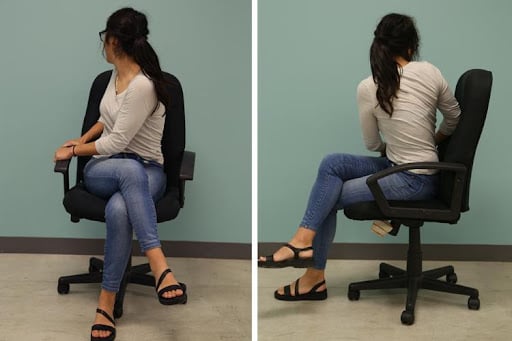
Source: Readers.com
- Seated Cat/Cow: In yoga, cat/cow is a simple posture that alternates your spine in an upward cure (cat) and downward arch (cow) while on your hands and knees. If you don’t want to get down on the floor in the middle of the workday (we understand), you can mimic the posture in your seat.
Start sitting tall with your hands on your knees. On an inhale, lift your gaze upward, arch your neck back, and expand your chest forward. On an exhale, round your head forward and suck in your stomach. Alternate 5-10 times between the postures.
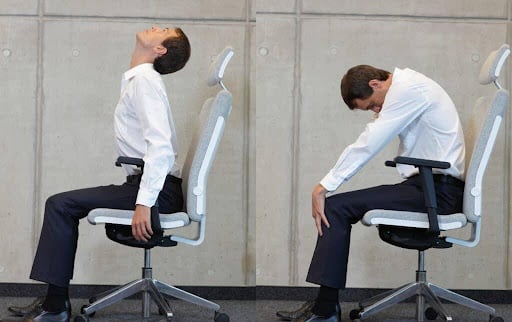
Source: Yogajala
- Seated hip flexor stretch (Chair Pigeon): The hips can easily become tight and fatigued after sitting too long. This cross-legged position externally rotates your hip flexor and glute to radiate relief throughout the lower back.
Sit up straight with your knees bent at a 90° angle and feet flat on the floor. Cross one leg over the other, so the ankle sits atop the opposite knee. Gently begin to press the outer knee of the crossed leg and hold for 10-15 seconds. Repeat on the other side.
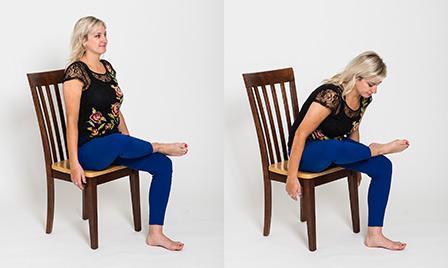
Source: Allina Health
- Seated Crescent Moon Pose: Add some yoga Zen to your office stretch routine by opening up the side body. Bring your hands straight overhead and touch your palms together. Inhale and reach up, then exhale and arch to one side. Feel your ribs expand away from your hips. Hold for 5 to 10 deep breaths and repeat on the other side.
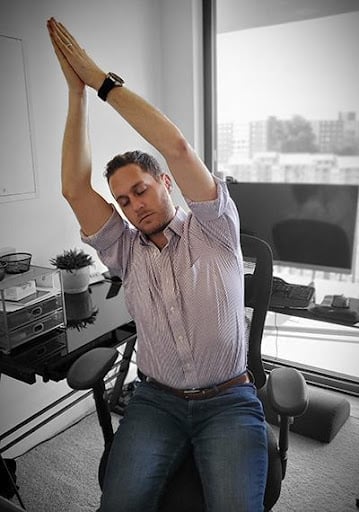
Source: Yoga Beyond the Studio
Office Chair Exercises
If you have a chair, you have no excuse! These office chair exercises offer the perfect 5-minute break between tasks.
- Office balance ball: Swap your chair out for a balance ball chair and feel the spinal difference! Balance balls are scientifically proven15https://journals.lww.com/nsca-jscr/fulltext/2010/11000/Effects_of_Swiss_Ball_Core_Strength_Training_on.19.aspx to improve low-back flexibility, and core strength challenges your balance and encourages good posture while you work.
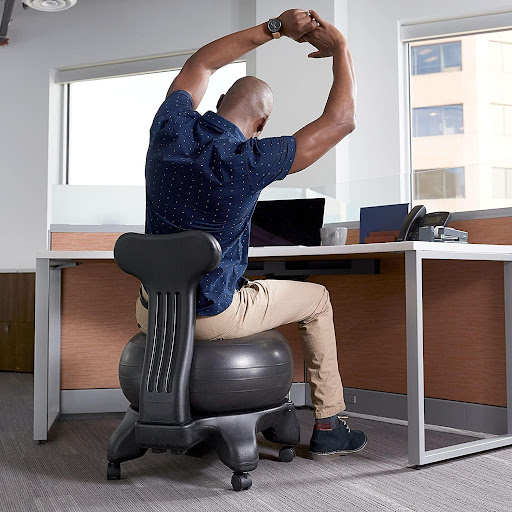
Source: Amazon
- Leg lifts: Challenge your quads and lower abdominal strength with leg lifts while you type. First, check that you are far enough from a wall or desk that you won’t kick anything. Then, sit back in your chair, press your tailbone down, and lightly engage your core. Then, flex all of the muscles in your legs as you slowly lift your feet from the floor until your legs are parallel in front of you. Hold for 5 seconds, then lower and repeat for 10 reps.

Source: Eat This Not That
- Tricep chair dips: If you have a stable lockable, or non-rolling office chair without arms, you can use it as a foundation for a quick upper-body exercise.
Sit on the edge of the chair and place your hands on each side to grip the edges of the seat. Position your feet hip-width apart and move your legs away from the chair as you move forward slightly. Lower yourself down until your elbows reach about 45 to a 90-degree angle, then push back up. You will feel the tricep muscles on the back of your upper arms working. Take care not to lock out your elbows. Repeat for 10-20 reps if you can.

Source: GoodRx
- Chair squats: Imagine sitting down with no chair beneath you. Most office workers are already primed for perfect squatting alignment. Simply stand up in front of your chair, widen your legs to a hip-width distance, and begin squatting down until your tailbone touches the chair. Lift back up and repeat for 10-20 reps or until you feel a nice muscle burn in your legs.

Source: Autonomous
- Resistance band glute push: Get the perfect office booty with one simple knee movement. Place a glute resistance band around your legs just above or below the knees. Sit up straight in your chair, grip the edges of the chair, and bring your feet hip-width apart. Begin to move your knees apart and then back together. You should feel activation through your outer glutes. Repeat for 20-50 reps.
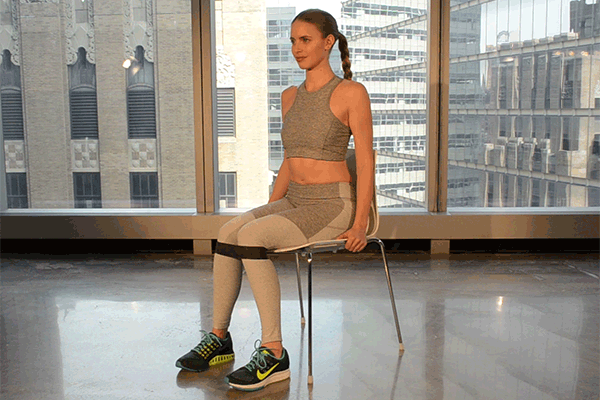
Source: Self.com
- Water bottle bicep curls: You probably don’t have any weights sitting around your office, but do you have a full water bottle? Perhaps a stapler or purse? Grasp any small weighted item in your hand and sit up straight in your chair. Keep your elbow tucked into your body as you extend your arm toward the floor and then curl the weight back up to your shoulder. Raise and lower 10-20 times on each arm.

Source: OhioHealth
- Arm circles: Strengthen your shoulders and warm up your arms with these quick arm-circle motions. Sit up straight and extend your arms out to the side so that your fingertips are in line with your shoulders. Imagine drawing circles in the air with your hands for 30 seconds, then reverse the direction. Experiment with different-sized circles and speeds.

Source: OhioHealth
- Office chair split squats: Bulgarian split squats are one of the best ways to build leg strength and muscles. As long as you have a stable office chair (or lockable wheels), this exercise can be performed almost anywhere.
Stand one to two feet in front of your chair with your feet hip-width apart. Lift the back leg and place the top of your foot on the chair so that your ankle is supported. Slowly lower your knee back and down until your front leg reaches about a 90° angle. Keep your torso upright and core engaged. Push back up to standing. Repeat for 10 reps and then do the other side.

Source: Power Life
Standing Office Exercises
Whether you invest in a standing workstation or you plan to get your heart pumping in between Zoom calls, these exercises require a little more space without taking up too much time.
- Standing desk: Studies show that standing desks promote greater productivity16https://www.tandfonline.com/doi/abs/10.1080/21577323.2016.1183534 and improve your health! You don’t even have to do squats to reap the benefits. A standing desk allows you to adjust the height of your workstation without compromising your focus. Moreover, it just feels so much better on your back.

Source: Amazon
- Under desk treadmill: If you want to take your standing desk to the next level, a desk treadmill or walking pad can keep you moving all day long. This innovative product allows you to get your cardio in while staying focused on your work.

Source: Getty/ Martin-dm
- Half Dog Pose: When your upper back, neck, and shoulders are killing you, all you need is a wall! Half Dog Pose is a wall-assisted variation of a yoga posture called Puppy Pose.
Watch this video guide for quick tips on how to do Half Dog Pose against a wall:
- Desk push ups: Build upper body strength and get your blood pumping without crouching on the dirty floor. Place both palms on your desk and walk backwards until your body is at about a 45° angle. Widen your hands slightly beyond your shoulders, engage your core, and do 10 pushups at a steady, slow pace. Practice exhaling as you push down and inhaling as you push up.

Source: Launch Workplaces
- Wall push-ups: If your desk isn’t strong enough to support a push-up, or you just want an easier variation, you can always build your chest strength against a wall. Stand facing a wall and extend your arms out in front of you with your palms flat against the surface. Take a few steps back to angle your body. Bend your elbows until your nose touches the wall and then press back out. Repeat three sets of 10.

Source: Musely
- Wall sits: Toned legs, mental clarity, and better posture? Yes, please! Start with your back against a wall and your feet shoulder-width apart. Slowly step your feet out until your knees reach a 90° angle. Try to get your thighs parallel to the ground and set a timer for 1 minute.
Make it fun and invite your coworkers for a friendly wall sit competition. Set a timer and see who can hold it the longest!

Source: Lili of the World
- Desk calf raises: This exercise invigorates your lower body, improves blood flow, and gives you chiseled runners calves without running! Simply stand at your standing desk or near a wall for balance. Lift up on your tippy toes, then lower your heels down. That’s one rep. Repeat for 50 or more reps.

Source: Stand Up Desk Store
- Standing glute kickbacks: Who knew you could get a toned booty while you type? This exercise integrates seamlessly with computer work at a standing desk. Simply stand straight with your hands on your desk or your hips. Kick your leg backwards as far as you can, hold for a few breaths, then lower it. Repeat for 20 reps and then do the other side.
For perfect form, follow along in this video:
- Leg balancing: Yes, standing on one leg counts as a workout too! Research shows that balance training improves memory17https://www.nature.com/articles/s41598-017-06071-9 and cognition. If you are deeply focused on a task, try shifting your weight into one leg while you work at your standing desk. Hold until your muscles start to shake, then switch sides.
Full body office workout routines
If you really want to upgrade your office fitness, here are some top-rated guided office workouts that take 10 minutes or less.
- Mood-boosting HIIT workout: When you’re feeling foggy, this guided 10-minute cardio routine can give you the boost you need to get through the rest of the day. No equipment required!
- Desk chair core workout: Tone those abdominal muscles and get your blood flow moving with this 5-minute core workout video.
- Energizing office break: Try this 10-minute workout break to clear your mind and invite your team to connect.
- 10-minute office yoga: In this video, Yoga With Christina takes you through a rejuvenating yoga routine you can do in your office chair.
- 5-minute no-equipment desk workout: Now you really have no excuse! Everyone can spare 5 minutes for this simple, low-impact workout. It is desk-friendly and doesn’t require any equipment.
- 10-minute neck and shoulders yoga: A stiff neck and sore shoulders can be incredibly distracting. This quick yoga stretch is soothing and relieving for anyone with a tense upper back.
- Desk dumbbell workout: Keep a couple of dumbbells by your desk so you can tone your arms in between virtual meetings.
- Office calorie burns: Torch the most calories possible with a 10-minute calorie-burning cardio workout. Just be sure you have the A/C blasting.
Mental office exercises
The brain needs exercise too! But scrolling on social media in between tasks is a productivity killer. Studies show it takes an average of 23 minutes to refocus18https://www.ics.uci.edu/~gmark/chi08-mark.pdf after scrolling! Instead, interrupt mind-numbing screentime with a mental break that can recalibrate your brain for better focus and less stress.
- Lunchtime walk: Sunshine truly is the best medicine! Research shows that an outdoor lunch break can boost your energy19https://news.uga.edu/low-intensity-exercise-reduces-fatigue-symptoms-by-65-percent-study-finds/ and mood20https://pubmed.ncbi.nlm.nih.gov/27100368/ while reducing your risk for cardiovascular disease. It also helps to break up your serious day with some laughter. Here are 30 Funny YouTube Videos to Watch During Your Lunch Break.
- 5-minute meditation: There are countless science-backed benefits of meditation, including improved focus, more creativity, and better memory.
Try this 5-minute productivity meditation:
- Jigsaw puzzle: Research shows that solving jigsaw puzzles improves memory21https://www.ncbi.nlm.nih.gov/pmc/articles/PMC6174231/, mental speed, and overall cognition. Keep an aesthetic jigsaw puzzle by your desk to toy around with in between tasks.
- Play cards: This 2015 study found that playing cards benefits the brain22https://www.ncbi.nlm.nih.gov/pmc/articles/PMC4417099/ by improving problem-solving skills and memory capacity. It may seem old-fashioned, but you could have a lot of fun playing a quick game of Solitaire or Speed with your coworkers.
- Cloud watching: If you only have a few minutes to rest your brain, try gazing out the window and finding shapes in the clouds. This simple mindfulness activity can make you feel calm and relaxed as you enjoy the present moment.
Here are another 30 Mindfulness Activities To Keep Your Mind Calm (At Any Age).
- Breathing exercises: Oxygenate your brain and refresh your mindset with a 5-minute breathing exercise that brings you to the present moment.
- Music break: The hum of office lights and computer chords isn’t always the most soothing background noise. When you have 3 minutes of spare time, turn on one of your favorite songs and sing along without any distractions. The challenge is just to sit there, be present, and enjoy the music!
- Reduce stress with EFT tapping: How could tapping your fingers on your face improve your brain function? Emotional Freedom Techniques (EFT tapping) are proven to reduce stress levels23https://psycnet.apa.org/doiLanding?doi=10.1037%2Ftra0000 and improve emotional regulation. Try this quick tap with thought leader Brad Yates to enhance brain performance:
- Set a timer and get lost in a book: If you’re a person who laments “never having time to read,” you may be surprised how much you can read during a workday and how much it can improve your mental state. During your lunch break, set a 5 or 10-minute timer and get lost in a book you enjoy.
- Creative visualization: Scientists have found that visualization (picturing something in your brain) increases creativity24https://journals.lww.com/ajnonline/Abstract/1998/12000/BODY_MIND_SPIRIT__The_Benefits_of_VISUALIZATION.41.aspx and promotes relaxation. When you’re desperate for new work ideas, try this 5-minute visualization exercise to recalibrate your focus and imagine your goals:
Key Takeaways: Prioritize Office Exercises that Address Your Pain Points
With so many exercise options right at your desk, you don’t have any more excuses for staying seated all day! Skyrocket your mood and productivity while reducing back pain and the health risks of a sedentary lifestyle.
If you want to incorporate more office exercises in your daily routine, remember to:
- Prioritize your pains and weak spots: If you have chronic low back pain, incorporate spinal stretches and core-strengthening workouts. If your neck is always hurting, try heart-opening yoga postures. If you have trouble focusing, give yourself a brain break with quick mental exercises.
- Find movements that you can do while working: Whether you invest in a standing desk or simply lift your legs up as you type; the best office exercises can happen almost subconsciously without disrupting workflow.
- Use timers to your advantage: When it’s time for a break, a 10-minute timer will keep you focused and dedicated without worrying about wasting time.
- Eliminate distractions: Put your phone down and turn off your screen for a moment so you can recalibrate your brain and focus on your fitness. Your body and mind will thank you later!
Office exercises are a simple yet profound way to level up your fitness and your life. Want more? Here are 10 Life-Changing Steps to Become the Best Version of Yourself.
Article sources
- https://jamanetwork.com/journals/jamacardiology/article-abstract/2793521
- https://pubmed.ncbi.nlm.nih.gov/28551361/
- https://journals.plos.org/plosone/article?id=10.1371/journal.pone.0122119
- https://pubmed.ncbi.nlm.nih.gov/25886270/
- https://news.sanfordhealth.org/heart/sitting-is-the-new-smoking-truly-a-silent-killer/
- https://www.ncbi.nlm.nih.gov/pmc/articles/PMC4960753/
- https://www.ncbi.nlm.nih.gov/pmc/articles/PMC5618737/
- https://bmcmusculoskeletdisord.biomedcentral.com/articles/10.1186/s12891-021-04136-5
- https://journals.sagepub.com/doi/pdf/10.1177/2165079917737558
- https://www.sciencedirect.com/science/article/pii/S0003687019301279
- https://www.mdpi.com/2411-5142/4/3/43
- https://healthmatters.nyp.org/how-to-prevent-tech-neck/
- https://journals.sagepub.com/doi/full/10.1177/00187208211045766
- https://www.jstage.jst.go.jp/article/indhealth/51/3/51_2012-0188/_article/-char/ja/
- https://journals.lww.com/nsca-jscr/fulltext/2010/11000/Effects_of_Swiss_Ball_Core_Strength_Training_on.19.aspx
- https://www.tandfonline.com/doi/abs/10.1080/21577323.2016.1183534
- https://www.nature.com/articles/s41598-017-06071-9
- https://www.ics.uci.edu/~gmark/chi08-mark.pdf
- https://news.uga.edu/low-intensity-exercise-reduces-fatigue-symptoms-by-65-percent-study-finds/
- https://pubmed.ncbi.nlm.nih.gov/27100368/
- https://www.ncbi.nlm.nih.gov/pmc/articles/PMC6174231/
- https://www.ncbi.nlm.nih.gov/pmc/articles/PMC4417099/
- https://psycnet.apa.org/doiLanding?doi=10.1037%2Ftra0000
- https://journals.lww.com/ajnonline/Abstract/1998/12000/BODY_MIND_SPIRIT__The_Benefits_of_VISUALIZATION.41.aspx
How to Deal with Difficult People at Work
Do you have a difficult boss? Colleague? Client? Learn how to transform your difficult relationship.
I’ll show you my science-based approach to building a strong, productive relationship with even the most difficult people.
